Labeling Machinery
Labels are applied—and in many cases required—for a wide range of uses, serving to communicate essential, variable information about the products to which they’re attached. Regulatory bodies like the Food and Drug Administration (FDA) often mandate specific data be displayed on labels to ensure product traceability and protect consumer health and safety. Items such as food and beverages feature nutritional facts and safety warnings, while also showcasing brand identity and visual design. Likewise, most retail goods carry branding elements alongside pricing and barcode labels, helping customers and sales staff identify, scan, and track items. Labels may also include product care instructions or function as organizational aids, signage, or integral parts of the product itself.
Labeling systems play a critical role across nearly every industry. One expert even called the label “perhaps the single most important marketing element on a package.” With the labeling industry generating an estimated $15 billion annually, it’s essential to understand the machinery, systems, and strategies behind effective label application.
History of Labeling Machinery
The labeling industry has taken shape over the past 300 years, built upon innovations that date back even further. The groundwork was laid with the invention of paper-making in 12th century southern Europe and the advent of the printing press in 1440. By the 1500s, Europeans were using labels to mark ownership of books donated to libraries and universities—an early method of attribution and recognition for significant gifts. Around the same time, labels were also being used to identify goods in transit, such as casks and bottles. With the rise of glass bottles in the late 1600s, labeling became essential for wine sold by the bottle. At that time, due to the irregular size of hand-blown bottles, the law allowed bottled wine to be sold only if labeled—ushering in the need for the first bottle labelers, particularly for vineyards serving wealthy clientele.
The Industrial Revolution sparked explosive growth in labeling, fueled by technological advances like the continuous paper-making machine, the development of lithographic and color printing, and innovations such as the bottle labeler and gummed paper. These breakthroughs carried labeling into the 20th century, where the momentum continued with the invention of self-adhesive label stock, automatic labeling machines, pressure-sensitive labelers, seal and fill machines, shrink labels, and a variety of dispensers and applicators—each playing a role in transforming the label into a central element of modern packaging and commerce.
Benefits of Labeling Machinery
There are numerous advantages to implementing a well-designed, fully integrated labeling system that aligns seamlessly with a business’s production plan. When labels are correctly applied and tracked, inventory and shipping operations become more efficient. Accurate labeling enables package tracking and reduces errors throughout the supply chain. Since federal regulations require specific information on product labels, a reliable labeling system also ensures regulatory compliance without slowing production. In fact, labeling can be either a source of costly delays or a powerful tool that keeps production running smoothly and products moving to market without interruption.
Labeling machinery plays a crucial role in helping businesses meet legal obligations. Regulations like the Competition and Consumer Act of 2010 require product labeling for a variety of reasons. Labels must deliver mandatory consumer information, display any industry-specific warnings or standards, and include special markings for imported goods to satisfy customs requirements.
Beyond legal compliance, labels are essential for meeting consumer expectations. Shoppers rely on them for critical information such as ingredients, manufacturing and expiration dates, usage instructions, warnings, and sustainability tips. Labels help consumers make informed choices while using the product safely and responsibly.
From a logistical standpoint, labeling systems streamline business operations. Barcode and UPC data printed on labels enable fast, accurate checkout at the point of sale, support traceability for recall purposes, and improve inventory tracking and management throughout the supply chain.
Finally, labeling systems serve a key marketing function. Studies show that roughly 35% of purchases are driven by attention-grabbing packaging, and as much as 70% of buying decisions are made in the store. This makes visually appealing labels a critical part of brand strategy, which is why companies invest heavily in labeling technology as part of their overall marketing budget.
Parts of a Labeling System
Labeling machinery performs two fundamental tasks: generating labels and affixing them to product containers. These two operations are often carried out through the coordinated use of multiple machines. A full labeling system typically integrates label makers, dispensers, and applicators, which function together under the guidance of specialized computer software. However, in some settings, each component may operate independently. Below is a breakdown of the roles and mechanisms behind these individual labeling machines.
Label Makers
Modern label makers are computerized printing devices available in handheld, benchtop, or floor-mounted configurations. These machines print labels using custom label-making software onto various types of stock materials such as paper, plastic, foil, or metal. Label stock is typically supplied in rolled or fanfold formats and is fed into the printer by an automated mechanism. Thermal printing is the most common method in industrial labeling. Digital thermal printers use heat-sensitive paper and a heated print head, producing ink-free labels that fade over time. In contrast, thermal transfer printers apply ink from a ribbon to the label using heat, offering greater durability at a higher cost due to the need for consumable ribbons.
Label Dispensers
Originally introduced in the 1920s, manual label dispensers helped streamline the process of separating labels from their backing paper. Workers would peel and apply the labels by hand. By the 1970s, electric label “gun” dispensers were developed, especially for the mailing industry, dramatically boosting output. For example, a task that once allowed 500 mail pieces to be labeled daily could now yield up to 2,000. These dispensers work by feeding label material through a roller mechanism to a peeler plate. The label is then separated from its backing and prepared for the applicator, while sensors and limit switches control material movement and positioning.
Applicators in the Labeling Process
Applicators automate the process of applying labels to containers. Typically positioned alongside moving packaging lines , these machines receive labels from dispensers and apply them as containers pass by. Printer applicators partially dispense the label, then apply it using either pressure-sensitive or heat-sensitive techniques, depending on the label type. The applicator collects the label while discarding the backing material onto a take-up spool. The label’s leading edge, or "flag," is positioned for application, and sensors align the label and product for precision. Once applied, the labeled product continues down the line toward further packaging or shipment.
Using Labeling Machinery
In large-scale industrial environments, labeling products requires a coordinated system composed of multiple machines. These systems are typically constructed from stainless steel for long-term durability and feature several key components. At the core is the label maker, a computer-controlled printer designed to generate custom labels. A feeder mechanism pushes blank label stock—either spooled or in fanfold form—into the printer. Once the label has been printed, it is passed along to the next stage in the process: the dispenser.
Labels can be applied to a wide range of substrates, and the nature of these surfaces plays a crucial role in determining which labeling machinery is appropriate. Some machines are built exclusively for flat or squared surfaces, while others are engineered specifically to label curved, tapered, or irregularly shaped items such as bottles or vials. In industries like pharmaceuticals, for instance, medical labelers must apply tamper-evident seals that wrap securely around the edges of small containers. Labeling systems that are not designed for such specialized applications may struggle to ensure precise placement or printing.
Labeling orientations include vertical or horizontal wrap labeling for full-surface coverage, as well as top, bottom, front, back, or combined placement for flat labels. Regardless of the placement or shape, compatibility between the label material, adhesive method, and substrate is essential. Commonly labeled materials include corrugated cardboard, paper, plastics, fibrous substrates, foils, films, and metals. Labels can be affixed using hot glue, pressure-sensitive adhesives, thermal transfer, stamping, or ink transfer. These adhesives may be part of the label's design or added just before application, depending on the type of labeler used—whether a basic applicator or a more advanced print-and-apply system.
Labeling System Images, Diagrams and Visual Concepts
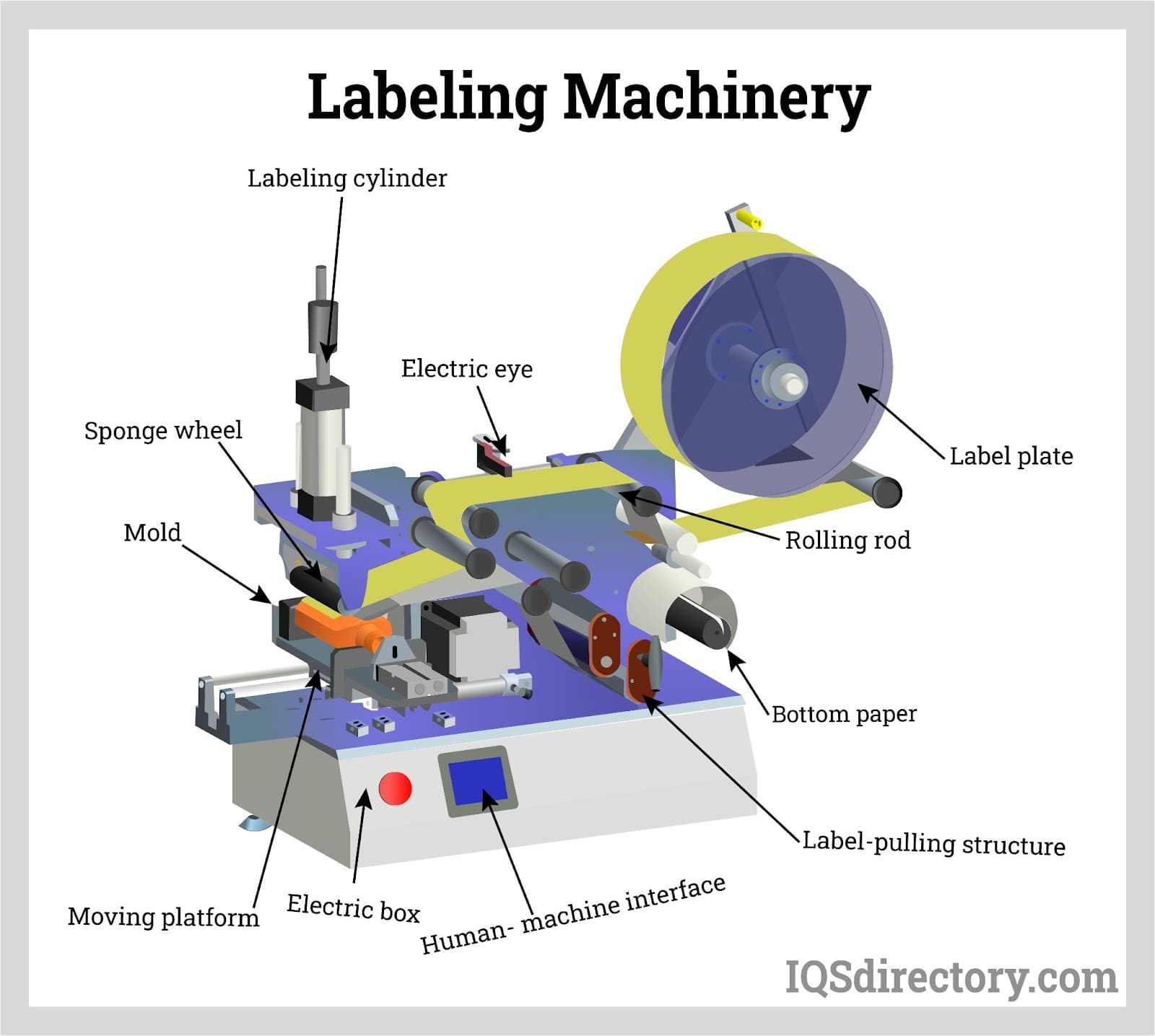 Labeling machinery refers to any equipment involved printing and attaching labels to the products and categorized based on the function.
Labeling machinery refers to any equipment involved printing and attaching labels to the products and categorized based on the function.
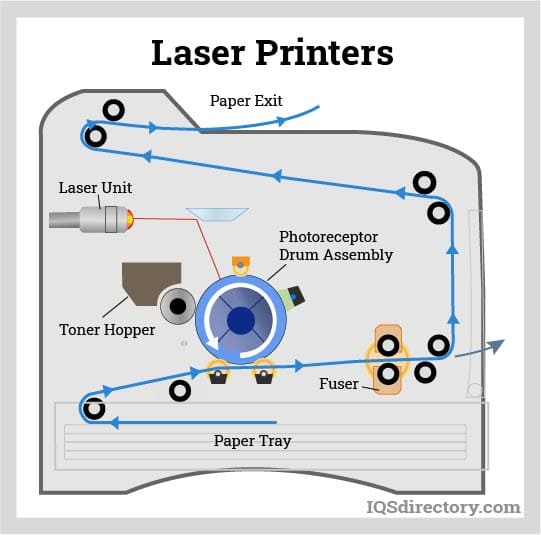 Laser printers can create multi-colored images, texts, and graphics quickly which can withstand UV light exposure, heat, and rubbing.
Laser printers can create multi-colored images, texts, and graphics quickly which can withstand UV light exposure, heat, and rubbing.
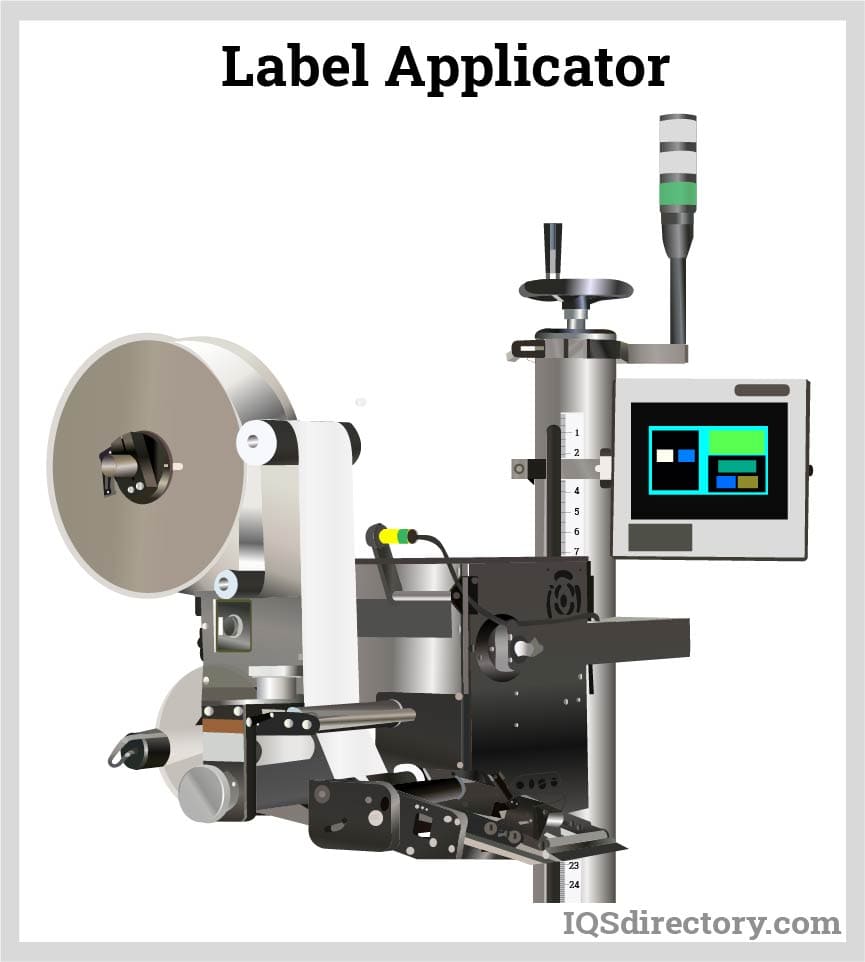 Label applicators, are labeling machines that attach pre-printed labels on films with pressure-sensitive adhesive on their backside, to products, containers, cases, and packages
Label applicators, are labeling machines that attach pre-printed labels on films with pressure-sensitive adhesive on their backside, to products, containers, cases, and packages
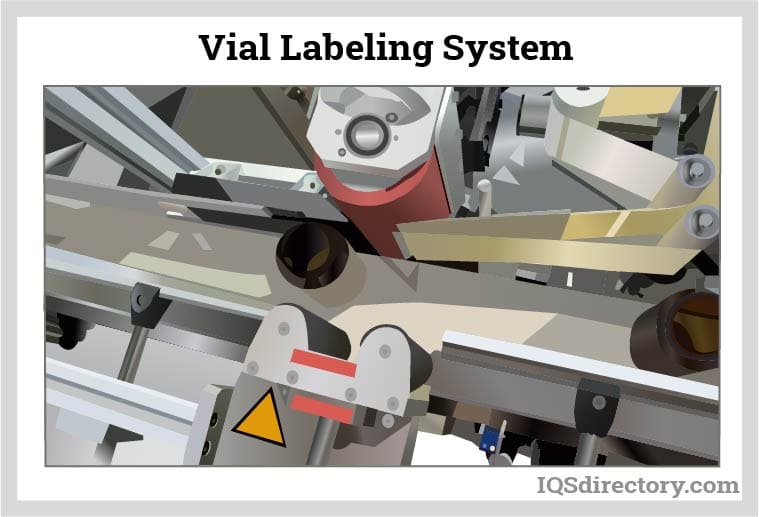 Vial labeling system, a wrap-around labeling system dedicated to attaching labels to vials.
Vial labeling system, a wrap-around labeling system dedicated to attaching labels to vials.
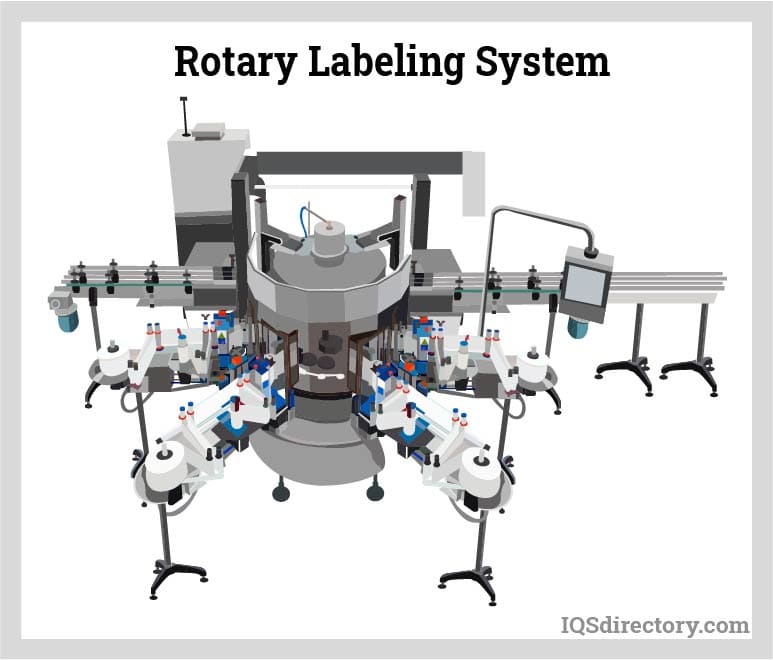 Rotary labeling systems, the products are transported from a linear direction to around a continuously rotating circular base
Rotary labeling systems, the products are transported from a linear direction to around a continuously rotating circular base
Types of Labeling Systems
Handheld Label Makers
The primary benefit of handheld label makers is their portability, making them ideal for on-site applications in industries like construction and warehousing. These units are typically compact, user-friendly, and cost-effective for basic labeling tasks.
Bench-Top Label Makers
Bench-top systems offer more versatility than handheld units and can produce large quantities of labels efficiently. They support a range of label formats including barcodes, text, graphics, tags, and wire markers. Many models can print on diverse materials such as paper, heat shrink sleeves, and specialty stocks, making them suitable for varied industrial and commercial uses.
Large Label-Makers
These floor-mounted machines are integral components of fully integrated labeling systems. Designed for large-scale operations, they can produce labels rapidly and in continuous runs. Their robust capabilities and advanced features make them well-suited for complex, high-volume labeling demands within factory and production environments.
Types of Labeling Machinery
-
Automatic Applicators
Used in high-volume labeling operations, automatic applicators apply labels to products or containers as they pass along a conveyor. A photo eye detects the item and triggers the precise placement of the label.
Barcode Labeling
This process involves generating and attaching compact, encoded tags that allow extensive data retrieval about individual products without relying on large or text-heavy labels.
Bottle Labelers
These machines are widely used across industries to label bottles, jars, and vials of various shapes and sizes for both branding and informational purposes.
Label Applicators
Automated machines designed to apply pre-printed labels directly to products or packaging surfaces.
Label Dispensers
Working alongside printers and applicators, dispensers assist in peeling labels from their backing. While they partially remove the backing automatically, full removal may be completed manually or by another automated device.
Label Machines
General-purpose systems capable of dispensing, printing, or applying labels onto packaging or products.
Label Makers
These are independent units used to design and produce labels, tags, and stickers. Though the term often refers to handheld devices for home or office use, larger industrial models fall under this category as well.
Label Printers
Specialized machines that print labels on a wide range of materials, including paper, ribbon, metal, plastic, fabric, ceramic, and film.
Labeler
A broad term encompassing any device or system designed to create or apply labels. It may refer to complete systems or individual components like dispensers, printers, or applicators.
Labeling Equipment
This includes all machinery used in the production and application of labels.
Labeling Machines
Systems that combine dispensing, printing, and applying functions to label products efficiently.
Labeling Systems
Integrated packaging solutions that print and apply labels to finished products, often as part of a larger production line.
Print and Apply Labelers
These machines print labels on demand and apply them immediately. Activation is typically triggered by a foot pedal, palm button, proximity switch, or sensor, with the operator resetting the process for the next product.
Applications for Industrial Printers
Industrial labeling systems serve a range of essential functions. They not only generate and apply marketing labels to product containers but also affix barcodes that store key product data. In addition, these systems are used to include critical consumer information, such as usage instructions, safety warnings, or regulatory disclosures.
Because of these varied roles, label printers are indispensable across virtually every industry. Sectors such as electronics, cosmetics, construction, pharmaceuticals, agriculture, food and beverage, chemicals, and healthcare all rely on labeling as a crucial stage of production. Nearly every manufacturing or commercial operation incorporates some form of labeling, making it a universal need. If you're searching for label printers, IQS Directory is an excellent place to start.
Customization of Labeling Systems
Few products genuinely qualify as "one size fits all," and this is particularly true when it comes to labeling machinery. The most effective labeling systems are those engineered with a specific customer’s requirements in mind. Because those requirements can vary widely—from the type of label material to the shape and texture of the container—it’s crucial that each system is customized for its intended use.
To ensure the successful development of a tailored labeling system, several key steps should be followed. First, assign a project manager to oversee the process and coordinate input across departments. Next, assemble a cross-functional team that includes members from all relevant areas, especially packaging development and engineering. Then, draft a comprehensive requirements document detailing the system’s functional needs and any special features it must include. From there, compile a shortlist of three to six capable vendors and issue a request for a quote to each. Finally, perform a vendor evaluation analysis based on the quotes received to objectively assess each proposal and select the best partner for building the customized labeling system.
Installation of Labeling Machinery
There are no unique installation requirements for handheld or bench-top label machines, as they are typically simple and ready for immediate use. However, the installation of large, multi-machine labeling systems involves a range of important factors that demand both expertise and experience. If not installed correctly, these systems can underperform or introduce inefficiencies that diminish the advantages a company expects to gain from its labeling operations. For this reason, it is highly advisable to enlist a qualified packaging engineer to supervise the installation process and ensure optimal performance from the outset.
Standards and Specifications for Labeling Machinery
Because labels convey critical information to consumers, federal law requires that labeling machinery produce labels in compliance with specific standards. These requirements were first outlined in 1978 by the American National Standards Institute (ANSI) and Underwriters Laboratories (UL) in the document titled Standards for Safety of Marking and Labeling Systems. This publication established two key benchmarks for label compliance. First, labels must be able to endure the environmental conditions to which they will be exposed. Second, the markings must remain durable, resisting smudging and deterioration when subjected to normal handling or contact with certain chemicals.
Things to Consider When Purchasing Labeling Machinery
Several important design considerations must be taken into account when selecting labeling machinery.
System Integration for OEE Monitoring
First, consider labeling equipment that can be integrated into systems measuring Overall Equipment Effectiveness (OEE). This allows businesses to track the productivity and performance of their labeling systems and identify ways to improve efficiency.
Flexible Equipment
Second, prioritize flexibility. As labeling regulations evolve, new markets open, or production requirements shift, your labeling needs may change. Investing in machinery with a wide range of capabilities ensures long-term adaptability and cost-effectiveness.
Reduced Downtime
Third, choose equipment specifically engineered to minimize downtime. Leading manufacturers are designing systems that reduce or eliminate time-consuming adjustments when changing label types or formats, helping to maintain production flow.
Production Line Speed Compatibility
Fourth, ensure the labeling system can match the speed of your overall production line. Labelers should be fast enough to meet daily targets but also be able to run at 15% to 20% below their maximum capacity. This margin reduces mechanical wear and extends the life of the equipment.
Production Requirements Communication
Fifth, fully communicate all production needs to your supplier, including minor operational details that could affect the system's design. It’s important to speak directly with the engineers and technicians who will be building the system. A layout graphic should also be provided to show exactly how the equipment will fit into the production line—including whether a left- or right-handed configuration is needed.
Factory Acceptance Test (FAT)
Finally, when requesting a quote, include a detailed request for a Factory Acceptance Test. This dry run simulates expected daily use and possible system failures before final delivery. While there may be additional costs, this test helps ensure the final system performs reliably under real-world conditions.
Labeling plays a vital role across industries—from food packaging to automotive parts. As such, it deserves careful attention and investment. For help finding a system that suits your specific needs, reach out to one of the experienced labeling equipment manufacturers listed at the top of this page
Labeling Machinery Terms
-
Acrylic Adhesive
Used with laser labels that rely on pressure-sensitive bonding, made from high-strength acrylic polymers.
Adhesion
The bond formed when two surfaces make contact, typically requiring at least 24 hours to achieve maximum adhesion strength.
Applicator
A device that automatically feeds and applies labels to products during the packaging process.
Barcode
A binary coding system read optically, using bars of varying widths or positions; these codes are printed mechanically for tracking and scanning.
Coated Paper
Paper finished with a surface coating to achieve a smooth texture, ranging from matte eggshell to high-gloss finishes.
Cold Temperature Adhesive
An adhesive designed to bond effectively to refrigerated or frozen surfaces at temperatures below 35°F.
Debossing
A technique that presses an image into the surface of paper, creating a recessed impression; the inverse of embossing, which raises the image.
Face Cut Label
A square-cut or die-cut label where the waste or matrix material between the labels is not removed.
Fan-Folded Labels
Continuous pressure-sensitive labels folded in alternating directions along perforations, forming a flat, stacked format.
High Temperature Adhesive
Formulated to perform in extreme heat, withstanding temperatures above 450°F.
Label
The functional component of a pressure-sensitive assembly, consisting of a face material and adhesive; available in various shapes and sizes.
Lift Tab
A portion of the label left without adhesive, allowing for easy peeling; commonly produced using a patterned adhesive coating.
Machine Readable
Refers to labels that can be scanned using laser scanners or similar devices; also called scannability.
Pattern Gummed Adhesive
A method of adhesive application that alternates bands of adhesive and non-adhesive material parallel to the machine’s direction, often used to create lift tabs.
Permanent Adhesive
Characterized by strong adhesion that cannot be cleanly removed, or requires significant effort for removal.
Pressure Sensitive Adhesive
A self-stick adhesive that bonds to various surfaces upon light hand pressure; adhesive strength determines whether it is removable or permanent.
Release
The act of removing a pressure-sensitive label from its liner or carrier; affected by the tension needed for separation.
Removability
The condition or ease with which a pressure-sensitive label can be peeled away from a surface without leaving residue or damage.
Static Cling Labels
Labels that adhere to surfaces via static electricity, requiring no adhesive.
Tacky
Describes the initial stickiness of an adhesive surface, allowing it to bond upon light contact and minimal pressure.
Web
A continuous roll of label stock, as opposed to individual sheets, typically used in high-speed printing presses.

